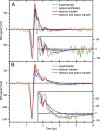Terahertz radiation from bacteriorhodopsin reveals correlated primary electron and proton transfer processes
- PMID: 18456840
- PMCID: PMC2383969
- DOI: 10.1073/pnas.0706336105
Terahertz radiation from bacteriorhodopsin reveals correlated primary electron and proton transfer processes
Abstract
The kinetics of electrogenic events associated with the different steps of the light-induced proton pump of bacteriorhodopsin is well studied in a wide range of time scales by direct electric methods. However, the investigation of the fundamental primary charge translocation phenomena taking place in the functional energy conversion process of this protein, and in other biomolecular assemblies using light energy, has remained experimentally unfeasible because of the lack of proper detection technique operating in the 0.1- to 20-THz region. Here, we show that extending the concept of the familiar Hertzian dipole emission into the extreme spatial and temporal range of intramolecular polarization processes provides an alternative way to study ultrafast electrogenic events on naturally ordered biological systems. Applying a relatively simple experimental arrangement based on this idea, we were able to observe light-induced coherent terahertz radiation from bacteriorhodopsin with femtosecond time resolution. The detected terahertz signal was analyzed by numerical simulation in the framework of different models for the elementary polarization processes. It was found that the principal component of the terahertz emission can be well described by excited-state intramolecular electron transfer within the retinal chromophore. An additional slower process is attributed to the earliest phase of the proton pump, probably occurring by the redistribution of a H bond near the retinal. The correlated electron and proton translocation supports the concept, assigning a functional role to the light-induced sudden polarization in retinal proteins.
Conflict of interest statement
The authors declare no conflict of interest.
Figures




Similar articles
-
Excitation of the M intermediates of bacteriorhodopsin.Photochem Photobiol. 2009 Mar-Apr;85(2):609-13. doi: 10.1111/j.1751-1097.2008.00521.x. Epub 2009 Feb 11. Photochem Photobiol. 2009. PMID: 19222799
-
Resonant optical rectification in bacteriorhodopsin.Proc Natl Acad Sci U S A. 2004 May 25;101(21):7971-5. doi: 10.1073/pnas.0306789101. Epub 2004 May 17. Proc Natl Acad Sci U S A. 2004. PMID: 15148391 Free PMC article.
-
Modeling of photocurrent kinetics upon pulsed photoexcitation of photosynthetic proteins: a case of bacteriorhodopsin.Bioelectrochemistry. 2014 Oct;99:1-7. doi: 10.1016/j.bioelechem.2014.05.003. Epub 2014 Jun 3. Bioelectrochemistry. 2014. PMID: 24935522
-
Bacteriorhodopsin: Structural Insights Revealed Using X-Ray Lasers and Synchrotron Radiation.Annu Rev Biochem. 2019 Jun 20;88:59-83. doi: 10.1146/annurev-biochem-013118-111327. Epub 2019 Apr 3. Annu Rev Biochem. 2019. PMID: 30830799 Review.
-
Hydration switch model for the proton transfer in the Schiff base region of bacteriorhodopsin.Biochim Biophys Acta. 2004 Jul 23;1658(1-2):72-9. doi: 10.1016/j.bbabio.2004.03.015. Biochim Biophys Acta. 2004. PMID: 15282177 Review.
Cited by
-
Molecular mechanism for thermal denaturation of thermophilic rhodopsin.Chem Sci. 2019 Jun 20;10(31):7365-7374. doi: 10.1039/c9sc00855a. eCollection 2019 Aug 21. Chem Sci. 2019. PMID: 31489158 Free PMC article.
-
Characteristic fingerprint spectrum of α-synuclein mutants on terahertz time-domain spectroscopy.Biophys J. 2024 May 21;123(10):1264-1273. doi: 10.1016/j.bpj.2024.04.011. Epub 2024 Apr 16. Biophys J. 2024. PMID: 38615192 Free PMC article.
-
Light-Induced Conformational Alterations in Heliorhodopsin Triggered by the Retinal Excited State.J Phys Chem B. 2021 Aug 12;125(31):8797-8804. doi: 10.1021/acs.jpcb.1c04551. Epub 2021 Aug 3. J Phys Chem B. 2021. PMID: 34342994 Free PMC article.
-
Vibrational motions associated with primary processes in bacteriorhodopsin studied by coherent infrared emission spectroscopy.Biophys J. 2011 Mar 16;100(6):1578-86. doi: 10.1016/j.bpj.2011.02.011. Biophys J. 2011. PMID: 21402041 Free PMC article.
-
Proton transfer reactions: From photochemistry to biochemistry and bioenergetics.BBA Adv. 2023 Mar 9;3:100085. doi: 10.1016/j.bbadva.2023.100085. eCollection 2023. BBA Adv. 2023. PMID: 37378355 Free PMC article.
References
-
- Ferguson B, Zhang XC. Materials for terahertz science and technology. Nat Mater. 2002;1:26–33. - PubMed
-
- Schmuttenmaer CA. Exploring dynamics in the far-infrared with terahertz spectroscopy. Chem Rev. 2004;104:1759–1779. - PubMed
-
- Carey JJ, et al. Terahertz pulse generation in an organic crystal by optical rectification and resonant excitation of molecular charge transfer. Appl Phys Lett. 2002;81:4335–4337.
-
- Beard MC, Turner GM, Schmuttenmaer CA. Measuring intramolecular charge transfer via coherent generation of THz radiation. J Phys Chem A. 2002;106:878–883.
Publication types
MeSH terms
Substances
LinkOut - more resources
Full Text Sources
Other Literature Sources

